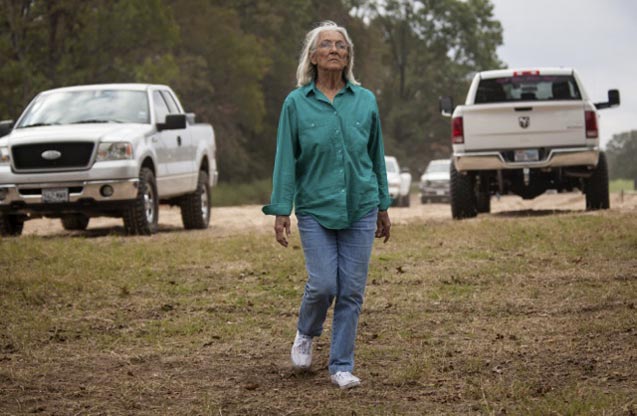
The Keystone XL pipeline’s southern route passes under Eleanor Fairchild’s Texas property, so she got angry when she learned that the Pipeline and Hazardous Materials Safety Administration (PHMSA) has added two new conditions to the 57 already required for construction of the pipeline’s northern route.
“My fears were confirmed,” Fairchild told DeSmogBlog. “The regulators knew the southern route wasn’t built safely. It is like they have said to hell with us in Texas and Oklahoma.”
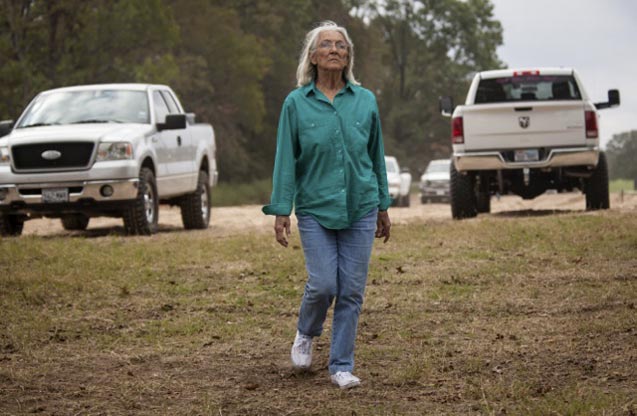 Eleanor Fairchild was defiant when TransCanada started installing the pipeline on her land. She kept a watchful eye during the installation and repair of the pipeline. ©2012 Julie Dermansky
Eleanor Fairchild was defiant when TransCanada started installing the pipeline on her land. She kept a watchful eye during the installation and repair of the pipeline. ©2012 Julie Dermansky
Julia Trigg Crawford, another Texas landowner who fought TransCanada in the courts, shared a link to an Associated Press story that focuses on the two new conditions. “Read this ASAP to see why Texans and Oklahomans were so outraged about TransCanada’s abysmal construction record on the southern leg of the Keystone XL,” she wrote.
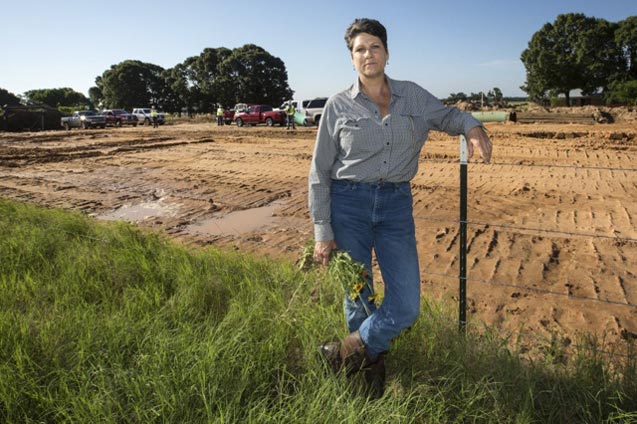 Julia Trigg Crawford was labeled an activist by TransCanada attorney James Freemand. She considers herself a patriot for standing up for all Americans’ property rights. ©2013 Julie Dermansky
Julia Trigg Crawford was labeled an activist by TransCanada attorney James Freemand. She considers herself a patriot for standing up for all Americans’ property rights. ©2013 Julie Dermansky
The conditions require TransCanada to hire a third-party contractor chosen by PHMSA to monitor the construction and make reports to the U.S. government on whether the work is sound. Additionally, TransCanada must “develop and implement a quality management system that would apply to the construction of the entire Keystone XL project in the U.S. to ensure that this pipeline is — from the beginning — built to the highest standards by both Keystone personnel and its many contractors.”
The Tar Sands Blockade, an activist group that independently monitored the pipeline installation after failing to stop it, wrote on its blog that the new conditions suggest there are serious problems with the southern route.
“TransCanada’s internal quality management and PHMSA’s external inspection program were inadequate, if not fatally flawed. The failures implied by these new conditions beg the question: If TransCanada wasn’t adequately inspecting its own work, and PHMSA didn’t have the third-party inspection company it needed for effective oversight, was anyone actually watching TransCanada?”
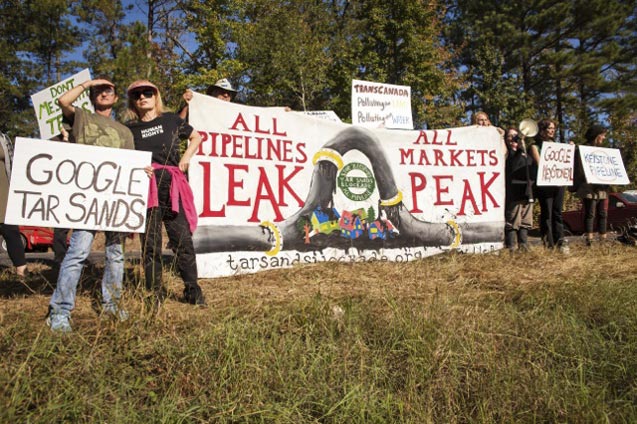 Tar Sands Blockade activists protesting against the Keystone XL pipeline at a construction site in Winnsboro, Texas. ©2012 Julie Dermansky
Tar Sands Blockade activists protesting against the Keystone XL pipeline at a construction site in Winnsboro, Texas. ©2012 Julie Dermansky
The new conditions weren’t based solely on the construction issues found in the southern route of the pipeline, now called the Gulf Coast pipeline. They were the result of “observations in the field during construction projects from several pipeline operators over the past few years,” Damon Hill, spokesperson for PHMSA, told the Associated Press.
The new conditions were based on “systemic problems regulators found in the pipeline industry, not just the Keystone XL’s southern route,” Richard Kurpewicz, president of Accufacts Inc., a consulting firm that provides pipeline expertise, told DeSmogBlog.
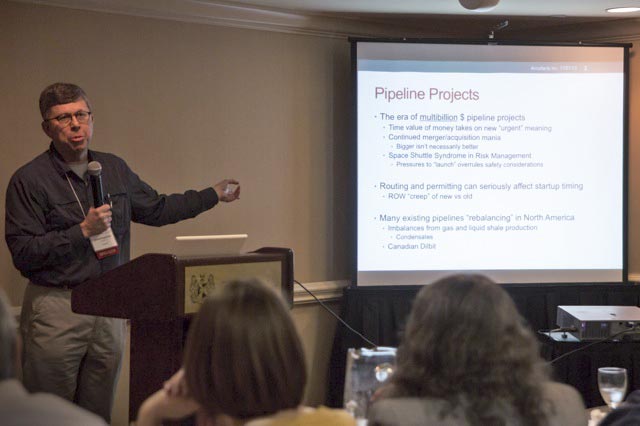 Richard Kurpewicz at a pipeline safety conference in New Orleans. ©2013 Julie Dermansky
Richard Kurpewicz at a pipeline safety conference in New Orleans. ©2013 Julie Dermansky
Fairchild and Crawford are part of a group of landowners who live with the southern route of the Keystone XL pipeline on their property and who, along with environmentalists, met with Roderick Seeley, director of the Southwest Region of PHMSA, to ask questions about the inspection process they witnessed in January.
The group presented documentation of shoddy construction practices and questioned the regulators about their absence during the pipeline installation and repair process. PHMSA representatives conceded they don’t have enough inspectors to watch everything but said, despite their absence in the field, they have “faith in the process.”
“At the meeting, PHMSA assured us that all the problems we referenced had been fixed, even though that assertion was based almost entirely on taking TransCanada’s word for it,” the Tar Sands Blockade recently wrote on its blog. “PHMSA’s inspections only occurred an average of 2-3 times per month.”
The group that attended the meeting requested that a new pressure test of the pipeline be done to test the welds on the numerous repairs. A pressure test can pinpoint faulty girth welds. For each repair that required a segment of pipe be replaced, new girth welds were made.
“If girth welds fail, there is the danger of a rupture,” Kurpewicz told DeSmogBlog.
Evan Vokes, a former TransCanada mechanical engineer turned whistleblower, points out: “Flaws in girth welds are not easy to catch, so each new section introduced into the pipeline adds another potential weakest link.” He too believes a new pressure test is merited.
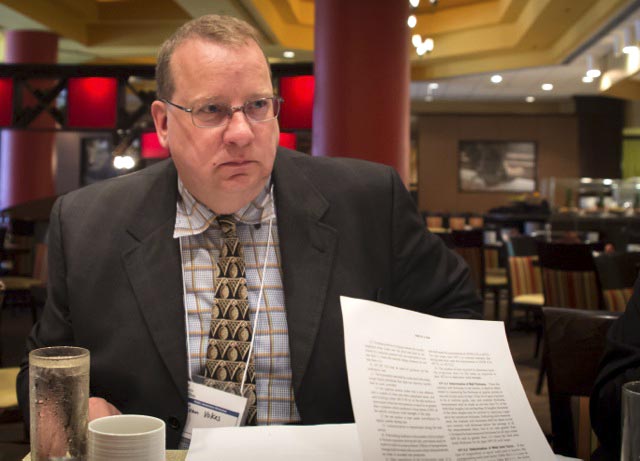 Evan Vokes at a pipeline safety conference in Dallas, Texas. ©2013 Julie Dermansky
Evan Vokes at a pipeline safety conference in Dallas, Texas. ©2013 Julie DermanskyThe new conditions PHSMA added to the U.S. Department of State Final Supplemental Environmental Impact Statement on the Keystone XL Pipeline came after meeting with the concerned landowners in January.
Crawford finds the timing suspect. “The new conditions indicate trust and faith are no longer enough for the regulatory agency,” she told DeSmogBlog.
According to the Associated Press story on the new conditions, the defects in the southern route of the pipeline “have all been fixed,” but the story doesn’t explain how they came to that conclusion.
TransCanada is singing from the same song sheet.
“The Gulf Coast Pipeline is the safest oil pipeline built in the United States to date,” Davis Sheremata, spokesman for TransCanada, told DeSmogBlog. “TransCanada is implementing a construction quality and integrity program like none before. The fact we conducted investigative digs after our inspections discovered these issues is a sign that our quality management programs work.”
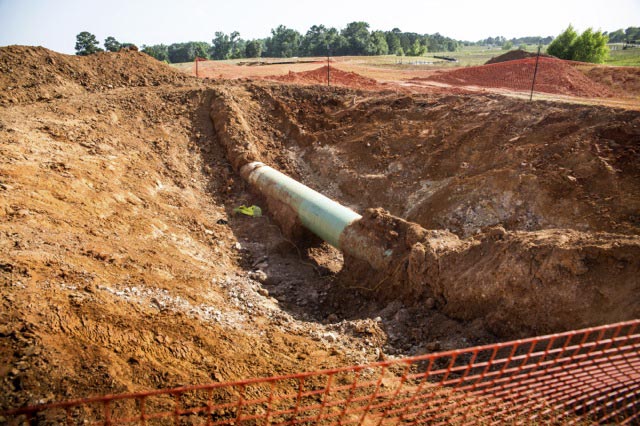 Repair site on the southern route of the Keystone XL in Texas. ©2013 Julie Dermansky
Repair site on the southern route of the Keystone XL in Texas. ©2013 Julie Dermansky
PHMSA’s warning letters to TransCanada and the advocacy group Public Citizen’s report about the southern route of the pipeline tell another story. A high rate of welding failures are cited by PHMSA, and Public Citizen’s report cites code violations that call into question the pipeline’s integrity.
“We have very few tools to work with,” Jeffrey Wiese, PHMSA’s safety official, told industry insiders at a pipeline safety conference in New Orleans in 2013, according to an Inside Climate News report. But that doesn’t explain why regulators did nothing more than issue warning letters to TransCanada after identifying code violations, opting not to fine or sanction the company.
Vokes doubts the new conditions will change anything. “If sanctions are not levied, there will be no improvement in the system,” he said.
“If PHMSA believes the public is in danger, they have the power to shut down a project,” Kurpewicz told DeSmogBlog.
And that is what the Tar Sands Blockade is asking PHMSA to do now. They have called for the pipeline to be shut down until a new pressure test is done.
Fairchild can’t understand why the government won’t require a new test. It was the government that allowed TransCanada to confiscate people’s land using eminent domain laws to build the pipeline, so the government should at least assure its safety.
In May, Fairchild reached a settlement with TransCanada over the company’s use of her land and a SLAPP suit. Criminal charges for trespassing on her own land with Daryl Hannah to stand in the path of earth-moving vehicles were dismissed as part of the settlement.
Fairchild insisted that TransCanada apologize to her for calling her an eco-terrorist before she would accept the settlement. She got the apology, but it is of little consolation since she is living next to a pipeline that she is certain will fail.
Our most important fundraising appeal of the year
December is the most critical time of year for Truthout, because our nonprofit news is funded almost entirely by individual donations from readers like you. So before you navigate away, we ask that you take just a second to support Truthout with a tax-deductible donation.
This year is a little different. We are up against a far-reaching, wide-scale attack on press freedom coming from the Trump administration. 2025 was a year of frightening censorship, news industry corporate consolidation, and worsening financial conditions for progressive nonprofits across the board.
We can only resist Trump’s agenda by cultivating a strong base of support. The right-wing mediasphere is funded comfortably by billionaire owners and venture capitalist philanthropists. At Truthout, we have you.
We’ve set an ambitious target for our year-end campaign — a goal of $250,000 to keep up our fight against authoritarianism in 2026. Please take a meaningful action in this fight: make a one-time or monthly donation to Truthout before December 31. If you have the means, please dig deep.